Chemical Reactions and Equilibrium Constants
VerifiedAdded on 2023/06/09
|6
|1578
|282
AI Summary
This study material covers various topics related to chemical reactions and equilibrium constants, including endothermic and exothermic reactions, calculating equilibrium constants, and determining reaction orders. It also includes examples and calculations for each topic. The subject and course code are not mentioned.
Contribute Materials
Your contribution can guide someone’s learning journey. Share your
documents today.
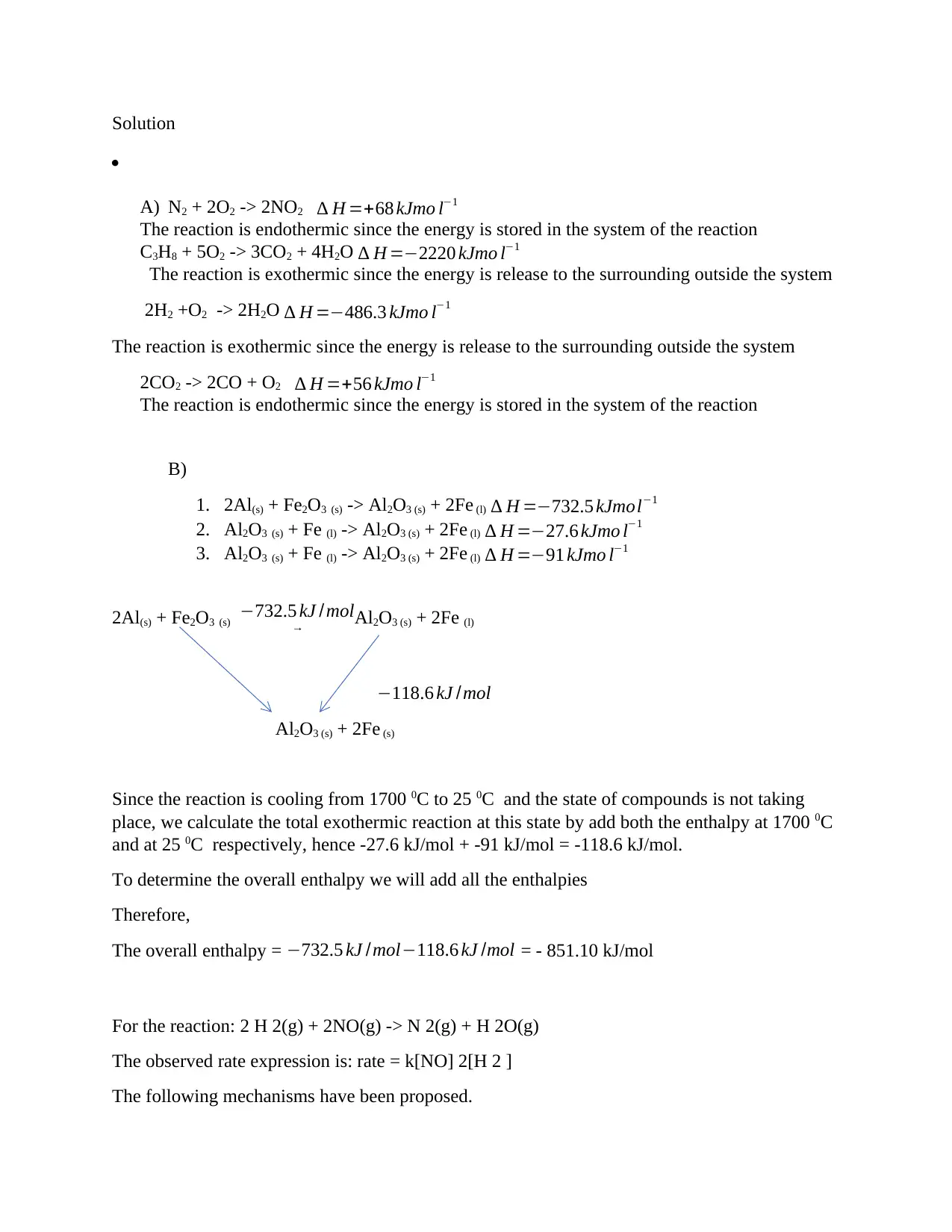
Solution
A) N2 + 2O2 -> 2NO2 ∆ H =+68 kJmo l−1
The reaction is endothermic since the energy is stored in the system of the reaction
C3H8 + 5O2 -> 3CO2 + 4H2O ∆ H =−2220 kJmo l−1
The reaction is exothermic since the energy is release to the surrounding outside the system
2H2 +O2 -> 2H2O ∆ H =−486.3 kJmo l−1
The reaction is exothermic since the energy is release to the surrounding outside the system
2CO2 -> 2CO + O2 ∆ H =+56 kJmo l−1
The reaction is endothermic since the energy is stored in the system of the reaction
B)
1. 2Al(s) + Fe2O3 (s) -> Al2O3 (s) + 2Fe (l) ∆ H =−732.5 kJmol−1
2. Al2O3 (s) + Fe (l) -> Al2O3 (s) + 2Fe (l) ∆ H =−27.6 kJmo l−1
3. Al2O3 (s) + Fe (l) -> Al2O3 (s) + 2Fe (l) ∆ H =−91 kJmo l−1
2Al(s) + Fe2O3 (s) −732.5 kJ /mol
→ Al2O3 (s) + 2Fe (l)
−118.6 kJ /mol
Al2O3 (s) + 2Fe (s)
Since the reaction is cooling from 1700 0C to 25 0C and the state of compounds is not taking
place, we calculate the total exothermic reaction at this state by add both the enthalpy at 1700 0C
and at 25 0C respectively, hence -27.6 kJ/mol + -91 kJ/mol = -118.6 kJ/mol.
To determine the overall enthalpy we will add all the enthalpies
Therefore,
The overall enthalpy = −732.5 kJ /mol−118.6 kJ /mol = - 851.10 kJ/mol
For the reaction: 2 H 2(g) + 2NO(g) -> N 2(g) + H 2O(g)
The observed rate expression is: rate = k[NO] 2[H 2 ]
The following mechanisms have been proposed.
A) N2 + 2O2 -> 2NO2 ∆ H =+68 kJmo l−1
The reaction is endothermic since the energy is stored in the system of the reaction
C3H8 + 5O2 -> 3CO2 + 4H2O ∆ H =−2220 kJmo l−1
The reaction is exothermic since the energy is release to the surrounding outside the system
2H2 +O2 -> 2H2O ∆ H =−486.3 kJmo l−1
The reaction is exothermic since the energy is release to the surrounding outside the system
2CO2 -> 2CO + O2 ∆ H =+56 kJmo l−1
The reaction is endothermic since the energy is stored in the system of the reaction
B)
1. 2Al(s) + Fe2O3 (s) -> Al2O3 (s) + 2Fe (l) ∆ H =−732.5 kJmol−1
2. Al2O3 (s) + Fe (l) -> Al2O3 (s) + 2Fe (l) ∆ H =−27.6 kJmo l−1
3. Al2O3 (s) + Fe (l) -> Al2O3 (s) + 2Fe (l) ∆ H =−91 kJmo l−1
2Al(s) + Fe2O3 (s) −732.5 kJ /mol
→ Al2O3 (s) + 2Fe (l)
−118.6 kJ /mol
Al2O3 (s) + 2Fe (s)
Since the reaction is cooling from 1700 0C to 25 0C and the state of compounds is not taking
place, we calculate the total exothermic reaction at this state by add both the enthalpy at 1700 0C
and at 25 0C respectively, hence -27.6 kJ/mol + -91 kJ/mol = -118.6 kJ/mol.
To determine the overall enthalpy we will add all the enthalpies
Therefore,
The overall enthalpy = −732.5 kJ /mol−118.6 kJ /mol = - 851.10 kJ/mol
For the reaction: 2 H 2(g) + 2NO(g) -> N 2(g) + H 2O(g)
The observed rate expression is: rate = k[NO] 2[H 2 ]
The following mechanisms have been proposed.
Secure Best Marks with AI Grader
Need help grading? Try our AI Grader for instant feedback on your assignments.
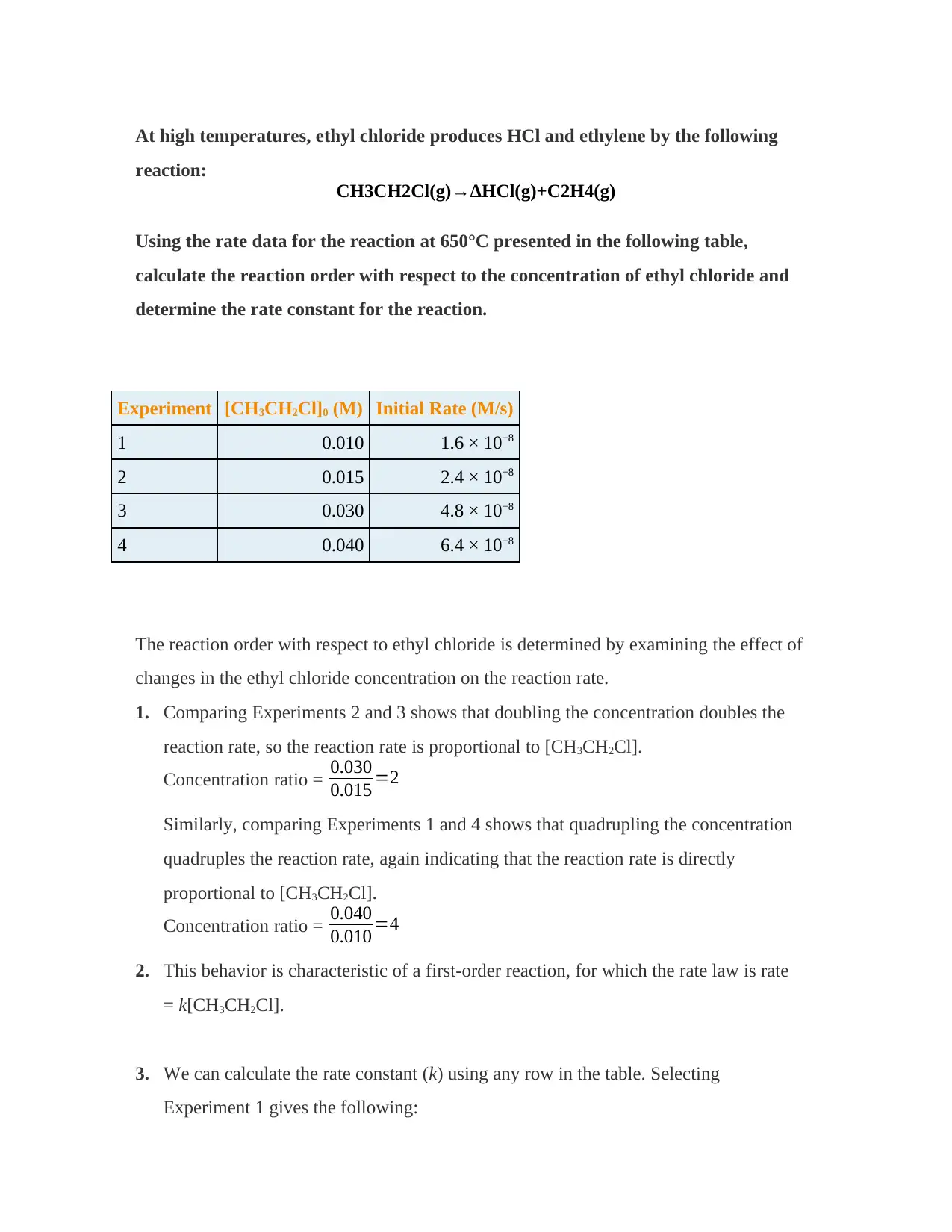
At high temperatures, ethyl chloride produces HCl and ethylene by the following
reaction:
CH3CH2Cl(g)→ΔHCl(g)+C2H4(g)
Using the rate data for the reaction at 650°C presented in the following table,
calculate the reaction order with respect to the concentration of ethyl chloride and
determine the rate constant for the reaction.
Experiment [CH3CH2Cl]0 (M) Initial Rate (M/s)
1 0.010 1.6 × 10−8
2 0.015 2.4 × 10−8
3 0.030 4.8 × 10−8
4 0.040 6.4 × 10−8
The reaction order with respect to ethyl chloride is determined by examining the effect of
changes in the ethyl chloride concentration on the reaction rate.
1. Comparing Experiments 2 and 3 shows that doubling the concentration doubles the
reaction rate, so the reaction rate is proportional to [CH3CH2Cl].
Concentration ratio = 0.030
0.015 =2
Similarly, comparing Experiments 1 and 4 shows that quadrupling the concentration
quadruples the reaction rate, again indicating that the reaction rate is directly
proportional to [CH3CH2Cl].
Concentration ratio = 0.040
0.010 =4
2. This behavior is characteristic of a first-order reaction, for which the rate law is rate
= k[CH3CH2Cl].
3. We can calculate the rate constant (k) using any row in the table. Selecting
Experiment 1 gives the following:
reaction:
CH3CH2Cl(g)→ΔHCl(g)+C2H4(g)
Using the rate data for the reaction at 650°C presented in the following table,
calculate the reaction order with respect to the concentration of ethyl chloride and
determine the rate constant for the reaction.
Experiment [CH3CH2Cl]0 (M) Initial Rate (M/s)
1 0.010 1.6 × 10−8
2 0.015 2.4 × 10−8
3 0.030 4.8 × 10−8
4 0.040 6.4 × 10−8
The reaction order with respect to ethyl chloride is determined by examining the effect of
changes in the ethyl chloride concentration on the reaction rate.
1. Comparing Experiments 2 and 3 shows that doubling the concentration doubles the
reaction rate, so the reaction rate is proportional to [CH3CH2Cl].
Concentration ratio = 0.030
0.015 =2
Similarly, comparing Experiments 1 and 4 shows that quadrupling the concentration
quadruples the reaction rate, again indicating that the reaction rate is directly
proportional to [CH3CH2Cl].
Concentration ratio = 0.040
0.010 =4
2. This behavior is characteristic of a first-order reaction, for which the rate law is rate
= k[CH3CH2Cl].
3. We can calculate the rate constant (k) using any row in the table. Selecting
Experiment 1 gives the following:
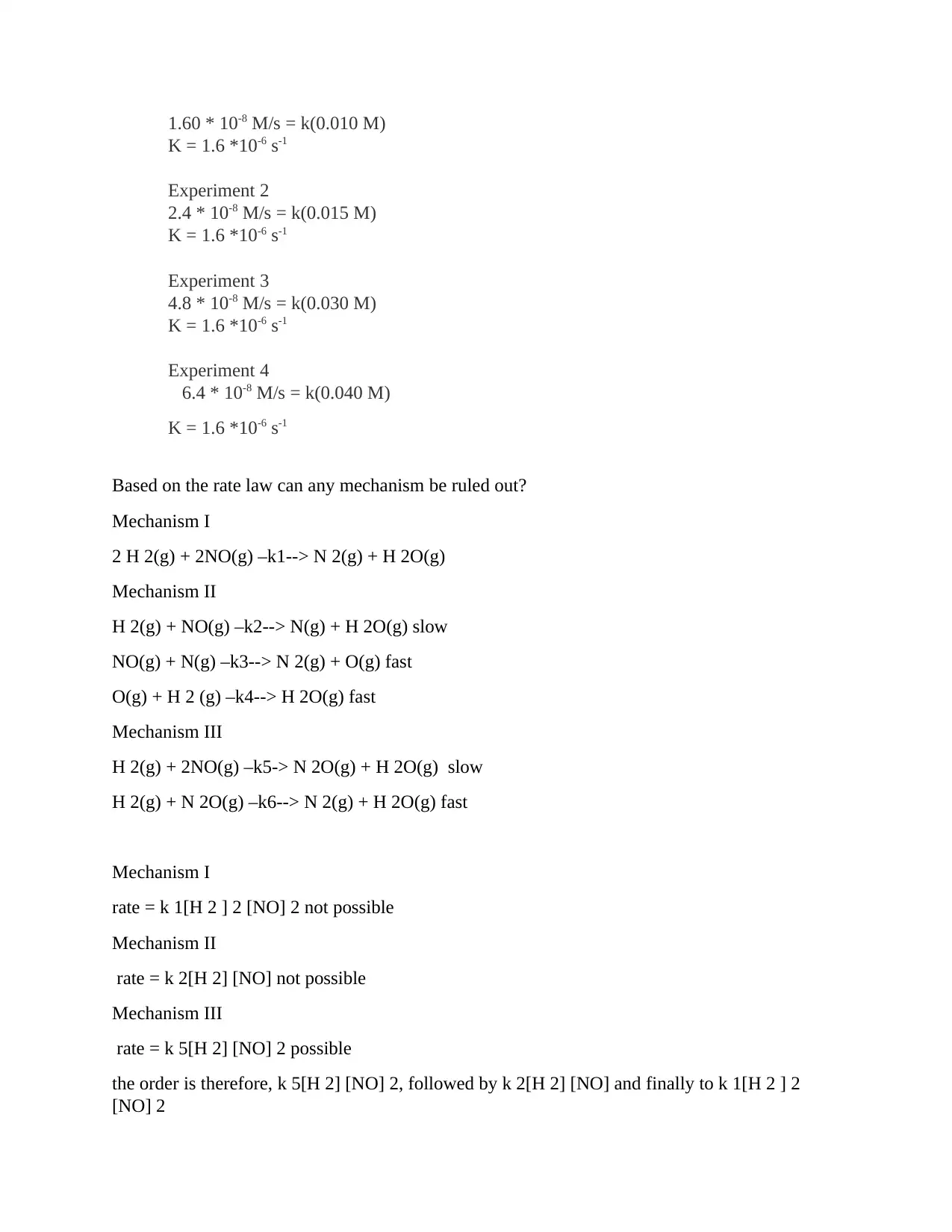
1.60 * 10-8 M/s = k(0.010 M)
K = 1.6 *10-6 s-1
Experiment 2
2.4 * 10-8 M/s = k(0.015 M)
K = 1.6 *10-6 s-1
Experiment 3
4.8 * 10-8 M/s = k(0.030 M)
K = 1.6 *10-6 s-1
Experiment 4
6.4 * 10-8 M/s = k(0.040 M)
K = 1.6 *10-6 s-1
Based on the rate law can any mechanism be ruled out?
Mechanism I
2 H 2(g) + 2NO(g) –k1--> N 2(g) + H 2O(g)
Mechanism II
H 2(g) + NO(g) –k2--> N(g) + H 2O(g) slow
NO(g) + N(g) –k3--> N 2(g) + O(g) fast
O(g) + H 2 (g) –k4--> H 2O(g) fast
Mechanism III
H 2(g) + 2NO(g) –k5-> N 2O(g) + H 2O(g) slow
H 2(g) + N 2O(g) –k6--> N 2(g) + H 2O(g) fast
Mechanism I
rate = k 1[H 2 ] 2 [NO] 2 not possible
Mechanism II
rate = k 2[H 2] [NO] not possible
Mechanism III
rate = k 5[H 2] [NO] 2 possible
the order is therefore, k 5[H 2] [NO] 2, followed by k 2[H 2] [NO] and finally to k 1[H 2 ] 2
[NO] 2
K = 1.6 *10-6 s-1
Experiment 2
2.4 * 10-8 M/s = k(0.015 M)
K = 1.6 *10-6 s-1
Experiment 3
4.8 * 10-8 M/s = k(0.030 M)
K = 1.6 *10-6 s-1
Experiment 4
6.4 * 10-8 M/s = k(0.040 M)
K = 1.6 *10-6 s-1
Based on the rate law can any mechanism be ruled out?
Mechanism I
2 H 2(g) + 2NO(g) –k1--> N 2(g) + H 2O(g)
Mechanism II
H 2(g) + NO(g) –k2--> N(g) + H 2O(g) slow
NO(g) + N(g) –k3--> N 2(g) + O(g) fast
O(g) + H 2 (g) –k4--> H 2O(g) fast
Mechanism III
H 2(g) + 2NO(g) –k5-> N 2O(g) + H 2O(g) slow
H 2(g) + N 2O(g) –k6--> N 2(g) + H 2O(g) fast
Mechanism I
rate = k 1[H 2 ] 2 [NO] 2 not possible
Mechanism II
rate = k 2[H 2] [NO] not possible
Mechanism III
rate = k 5[H 2] [NO] 2 possible
the order is therefore, k 5[H 2] [NO] 2, followed by k 2[H 2] [NO] and finally to k 1[H 2 ] 2
[NO] 2
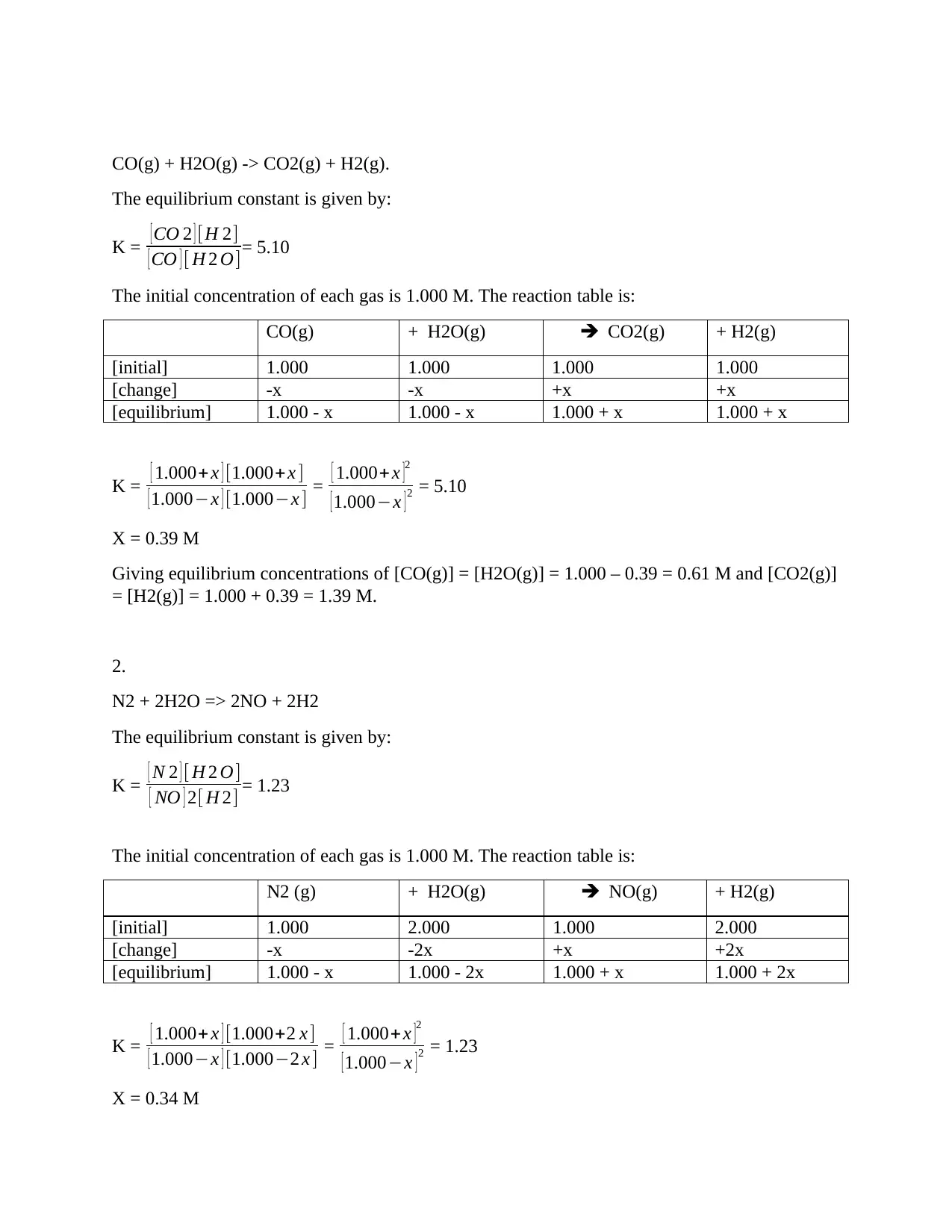
CO(g) + H2O(g) -> CO2(g) + H2(g).
The equilibrium constant is given by:
K = [CO 2 ] [H 2]
[CO ] [ H 2 O]= 5.10
The initial concentration of each gas is 1.000 M. The reaction table is:
CO(g) + H2O(g) CO2(g) + H2(g)
[initial] 1.000 1.000 1.000 1.000
[change] -x -x +x +x
[equilibrium] 1.000 - x 1.000 - x 1.000 + x 1.000 + x
K = [ 1.000+ x ] [1.000+x ]
[ 1.000−x ] [1.000−x ] = [ 1.000+x ]2
[ 1.000−x ] 2 = 5.10
X = 0.39 M
Giving equilibrium concentrations of [CO(g)] = [H2O(g)] = 1.000 – 0.39 = 0.61 M and [CO2(g)]
= [H2(g)] = 1.000 + 0.39 = 1.39 M.
2.
N2 + 2H2O => 2NO + 2H2
The equilibrium constant is given by:
K = [ N 2 ] [ H 2 O]
[ NO ] 2[ H 2] = 1.23
The initial concentration of each gas is 1.000 M. The reaction table is:
N2 (g) + H2O(g) NO(g) + H2(g)
[initial] 1.000 2.000 1.000 2.000
[change] -x -2x +x +2x
[equilibrium] 1.000 - x 1.000 - 2x 1.000 + x 1.000 + 2x
K = [ 1.000+ x ] [1.000+2 x ]
[1.000−x ] [1.000−2 x ] = [ 1.000+x ]2
[1.000−x ]2 = 1.23
X = 0.34 M
The equilibrium constant is given by:
K = [CO 2 ] [H 2]
[CO ] [ H 2 O]= 5.10
The initial concentration of each gas is 1.000 M. The reaction table is:
CO(g) + H2O(g) CO2(g) + H2(g)
[initial] 1.000 1.000 1.000 1.000
[change] -x -x +x +x
[equilibrium] 1.000 - x 1.000 - x 1.000 + x 1.000 + x
K = [ 1.000+ x ] [1.000+x ]
[ 1.000−x ] [1.000−x ] = [ 1.000+x ]2
[ 1.000−x ] 2 = 5.10
X = 0.39 M
Giving equilibrium concentrations of [CO(g)] = [H2O(g)] = 1.000 – 0.39 = 0.61 M and [CO2(g)]
= [H2(g)] = 1.000 + 0.39 = 1.39 M.
2.
N2 + 2H2O => 2NO + 2H2
The equilibrium constant is given by:
K = [ N 2 ] [ H 2 O]
[ NO ] 2[ H 2] = 1.23
The initial concentration of each gas is 1.000 M. The reaction table is:
N2 (g) + H2O(g) NO(g) + H2(g)
[initial] 1.000 2.000 1.000 2.000
[change] -x -2x +x +2x
[equilibrium] 1.000 - x 1.000 - 2x 1.000 + x 1.000 + 2x
K = [ 1.000+ x ] [1.000+2 x ]
[1.000−x ] [1.000−2 x ] = [ 1.000+x ]2
[1.000−x ]2 = 1.23
X = 0.34 M
Secure Best Marks with AI Grader
Need help grading? Try our AI Grader for instant feedback on your assignments.
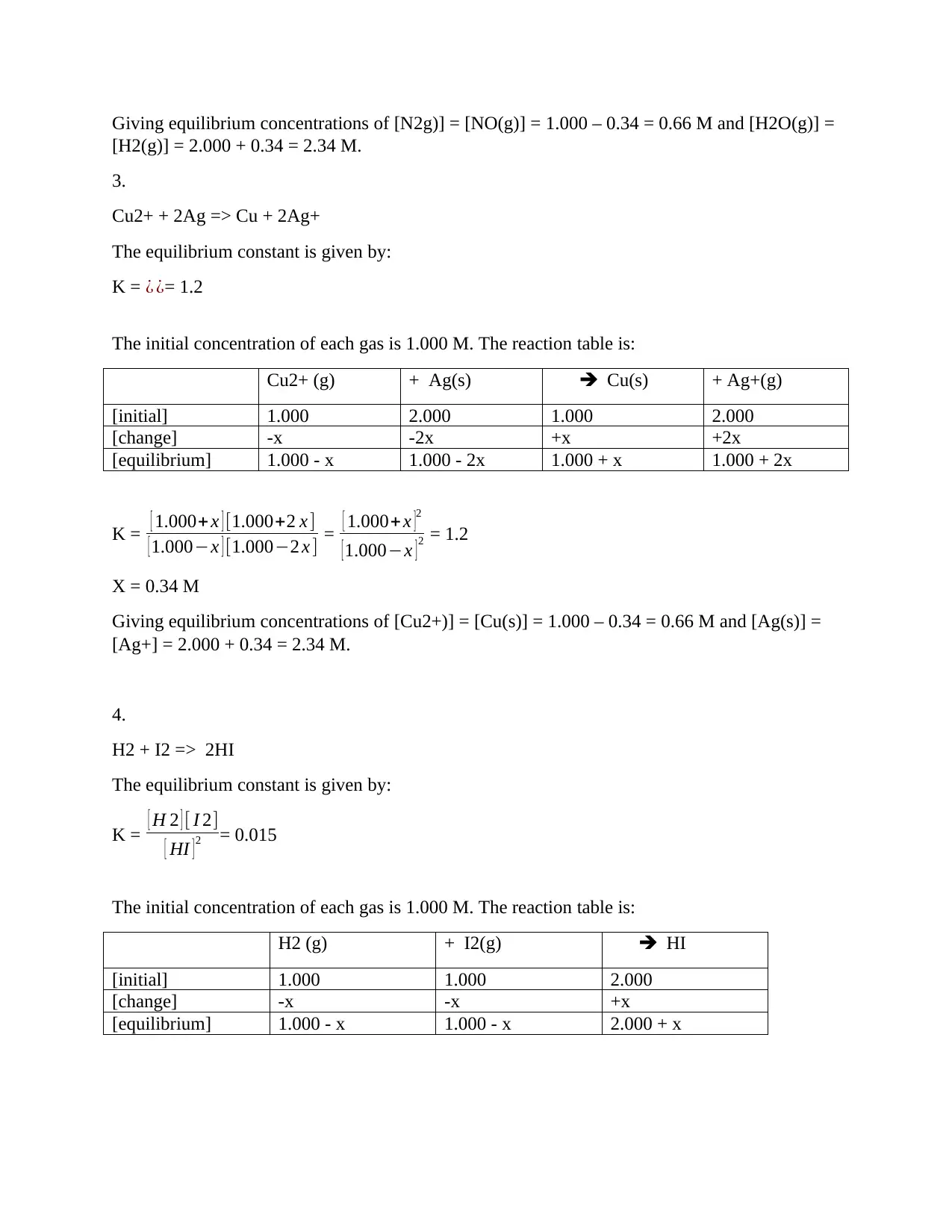
Giving equilibrium concentrations of [N2g)] = [NO(g)] = 1.000 – 0.34 = 0.66 M and [H2O(g)] =
[H2(g)] = 2.000 + 0.34 = 2.34 M.
3.
Cu2+ + 2Ag => Cu + 2Ag+
The equilibrium constant is given by:
K = ¿ ¿= 1.2
The initial concentration of each gas is 1.000 M. The reaction table is:
Cu2+ (g) + Ag(s) Cu(s) + Ag+(g)
[initial] 1.000 2.000 1.000 2.000
[change] -x -2x +x +2x
[equilibrium] 1.000 - x 1.000 - 2x 1.000 + x 1.000 + 2x
K = [ 1.000+ x ] [1.000+2 x ]
[1.000−x ] [1.000−2 x ] = [ 1.000+x ]2
[ 1.000−x ] 2 = 1.2
X = 0.34 M
Giving equilibrium concentrations of [Cu2+)] = [Cu(s)] = 1.000 – 0.34 = 0.66 M and [Ag(s)] =
[Ag+] = 2.000 + 0.34 = 2.34 M.
4.
H2 + I2 => 2HI
The equilibrium constant is given by:
K = [ H 2 ] [ I 2]
[ HI ] 2 = 0.015
The initial concentration of each gas is 1.000 M. The reaction table is:
H2 (g) + I2(g) HI
[initial] 1.000 1.000 2.000
[change] -x -x +x
[equilibrium] 1.000 - x 1.000 - x 2.000 + x
[H2(g)] = 2.000 + 0.34 = 2.34 M.
3.
Cu2+ + 2Ag => Cu + 2Ag+
The equilibrium constant is given by:
K = ¿ ¿= 1.2
The initial concentration of each gas is 1.000 M. The reaction table is:
Cu2+ (g) + Ag(s) Cu(s) + Ag+(g)
[initial] 1.000 2.000 1.000 2.000
[change] -x -2x +x +2x
[equilibrium] 1.000 - x 1.000 - 2x 1.000 + x 1.000 + 2x
K = [ 1.000+ x ] [1.000+2 x ]
[1.000−x ] [1.000−2 x ] = [ 1.000+x ]2
[ 1.000−x ] 2 = 1.2
X = 0.34 M
Giving equilibrium concentrations of [Cu2+)] = [Cu(s)] = 1.000 – 0.34 = 0.66 M and [Ag(s)] =
[Ag+] = 2.000 + 0.34 = 2.34 M.
4.
H2 + I2 => 2HI
The equilibrium constant is given by:
K = [ H 2 ] [ I 2]
[ HI ] 2 = 0.015
The initial concentration of each gas is 1.000 M. The reaction table is:
H2 (g) + I2(g) HI
[initial] 1.000 1.000 2.000
[change] -x -x +x
[equilibrium] 1.000 - x 1.000 - x 2.000 + x
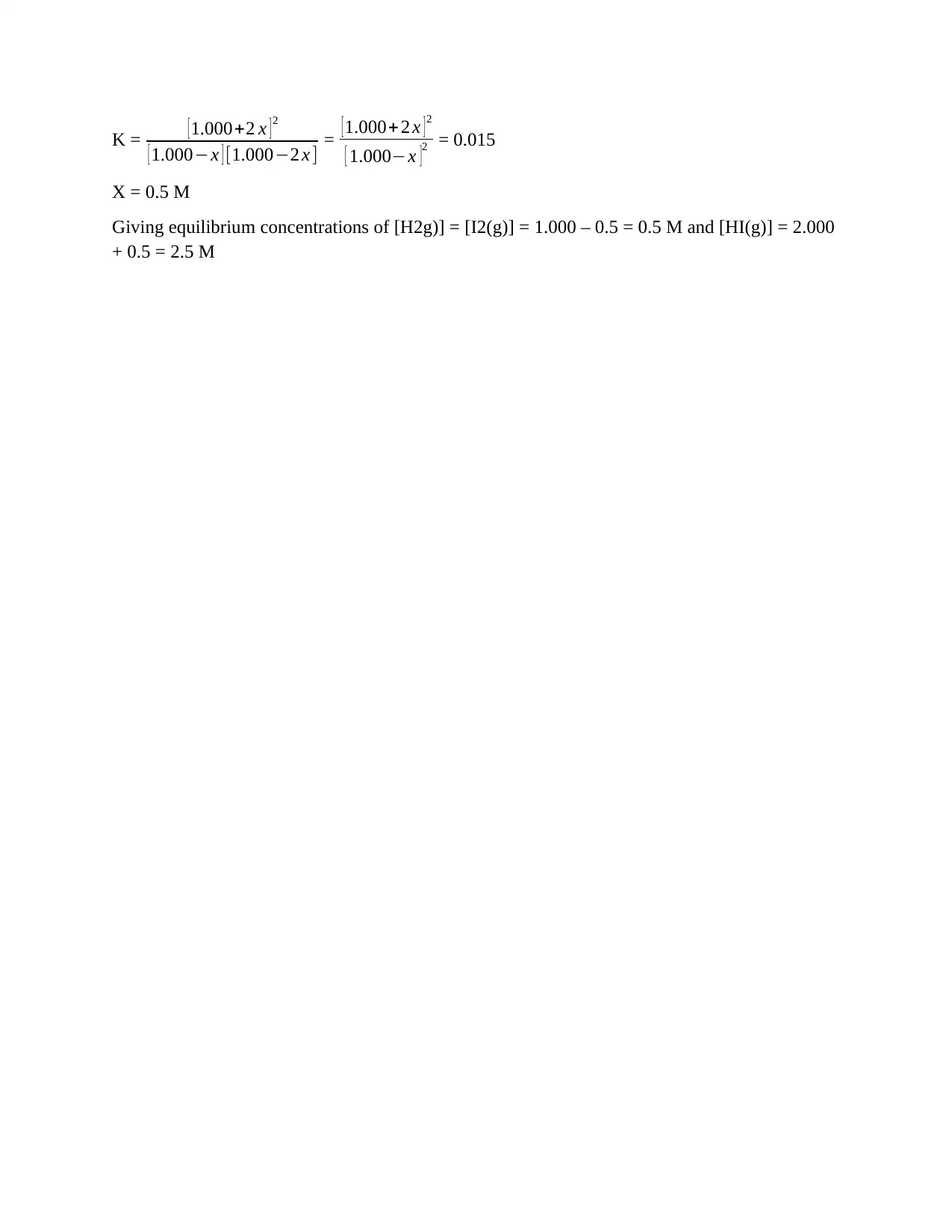
K = [1.000+2 x ]2
[1.000−x ] [1.000−2 x ] = [ 1.000+ 2 x ] 2
[ 1.000−x ]
2 = 0.015
X = 0.5 M
Giving equilibrium concentrations of [H2g)] = [I2(g)] = 1.000 – 0.5 = 0.5 M and [HI(g)] = 2.000
+ 0.5 = 2.5 M
[1.000−x ] [1.000−2 x ] = [ 1.000+ 2 x ] 2
[ 1.000−x ]
2 = 0.015
X = 0.5 M
Giving equilibrium concentrations of [H2g)] = [I2(g)] = 1.000 – 0.5 = 0.5 M and [HI(g)] = 2.000
+ 0.5 = 2.5 M
1 out of 6
Your All-in-One AI-Powered Toolkit for Academic Success.
+13062052269
info@desklib.com
Available 24*7 on WhatsApp / Email
![[object Object]](/_next/static/media/star-bottom.7253800d.svg)
Unlock your academic potential
© 2024 | Zucol Services PVT LTD | All rights reserved.
